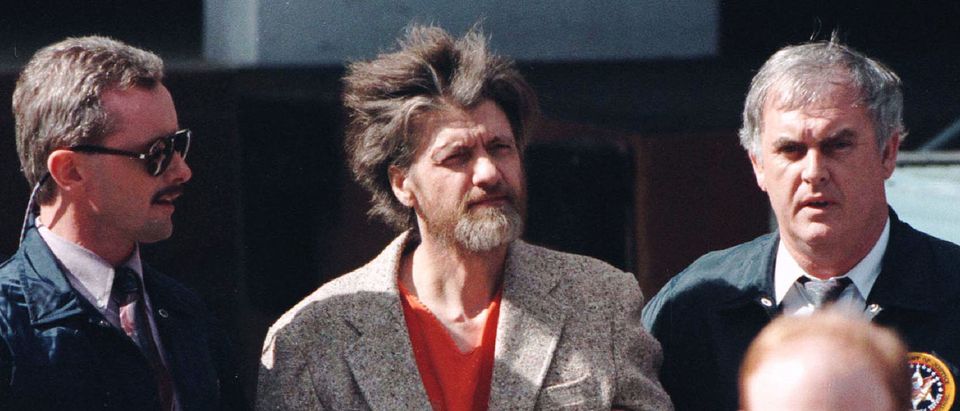Austin-area residents breathed a collective sigh of relief Wednesday morning, when authorities announced the suspect in a bombing spree killed himself following a police chase.
The suspect, identified as 23-year-old Mark Anthony Conditt, allegedly killed two people and injured three others in a series of bombings across the Austin area. Local residents were gripped by fear for nearly three weeks, not knowing where and when the next bomb would explode or who would be targeted.
Federal agents and local police have began searching Conditt’s home on Wednesday for clues as to why a seemingly peaceful, shy young man would methodically plan to murder complete strangers. Investigators have yet to discover Conditt’s motive, leaving the public to make comparisons to other serial bombers in recent memory:
The ‘Unabomber’
The Austin bombing spree evoked memories of the most notorious serial bomber in U.S. history, Ted Kaczynski. Better known as the Unabomber, Kaczynski carried out a bombing campaign between 1978 and 1995 that killed three people and injured 23 others.
The most obvious parallel between the Conditt and Kaczynski cases is both men used package bombs in some but not all of their attacks. In those incidents, homemade bombs rigged with pressure triggers detonated when victims picked up or opened them.
Fortunately, Conditt was caught before he could match Kaczynski’s level and duration of violence. All told, the Unabomber was responsible 16 bombings over 17 years, with victims in eight states and an airplane in mid flight.
Kaczynski’s unorthodox political ideology was the inspiration for his two-decade bombing spree laid out in an infamous manifesto, “Industrial Society and Its Future.” In it, he lamented the rise of technology and modern industry, which he blamed on widespread alienation and psychological suffering in contemporary society.
Kaczynski’s victims were all affiliated with institutions and industries he saw as particularly culpable for technology’s takeover of modern life. In fact, the Unabomber moniker originated as a portmanteau of his bombing targets: “University and Airline Bomber.”
Kaczynski was arrested in 1996, after one of the longest and most expensive investigations in FBI history. The big break in the case came from Kaczyinski’s brother, David, who tipped off investigators the writing in the manifesto was similar to Ted’s.
The Unabomber is serving multiple life sentences at ADX Florence, a supermax prison in Florence, Colo.
‘Olympic Park Bomber’
Though the Unabomber overshadows him, Eric Rudolph’s bombing spree across the South generated as much fear and media attention because of his first target: the 1996 Atlanta Olympics.
A bomb blast ripped through Atlanta’s Centennial Olympic Park in the early morning hours of July 28, 1996, killing two people and wounding more than 100 others. Rudolph, who was not arrested until 2003, said he carried out the bombing to strike at the U.S. government and multinational corporations, which he said were promoting “global socialism” and “abortion on demand.”
Rudolph’s politics also inspired three other bombings he committed between 1997 an 1998: an abortion clinic and lesbian nightclub in Atlanta, and an abortion clinic in Birmingham, Ala. The last of those attacks killed a police officer working as a part-time security guard at the clinic.
Following his arrest and trial, Rudolph was convicted and sentenced to two life sentences without the possibility of parole. Like Kaczynski, Rudolph is incarcerated at ADX Florence.
‘Midwest Pipe Bomber’
Before Conditt, the most recent of the nationally known serial bombers was Lucas Helder, who gained notoriety in 2002 as the Midwest Pipe Bomber.
In a five-day, six-state bombing spree, Helder planted 18 pipe bombs packed with shrapnel in mailboxes, which were rigged to explode when someone opened them. The bombs injured six people, including four mail carriers, but no deaths resulted.
A University of Wisconsin-Stout student at the time of the bombings, Helder espoused a belief in astral projection, which is a concept entaililng people having willful out-of-body experiences by separating their souls from their physical bodies. Helder was “dismissing a few individuals from reality, to change all of you for the better,” he said in a manifesto sent to the University of Wisconsin-Madison’s campus newspaper.
Bizarrely, Helder intended to map out a smiley face across the country with his mailbox bombings. He planted devices in Iowa, Illinois, Nebraska, Texas and Colorado but was arrested in rural Nevada before he could complete the full smile.
A federal judge found Helder incompetent to stand trial in 2004, and he was later diagnosed with a schizoaffective disorder. He remains incarcerated in a mental institution in Minnesota.
ALSO WATCH The Washington Post crusades against 2nd Amendment and claims guns keep white men on top:
Send tips to will@dailycallernewsfoundation.org.
All content created by the Daily Caller News Foundation, an independent and nonpartisan newswire service, is available without charge to any legitimate news publisher that can provide a large audience. All republished articles must include our logo, our reporter’s byline and their DCNF affiliation. For any questions about our guidelines or partnering with us, please contact licensing@dailycallernewsfoundation.org.












